|
|
|
|
Damage Caused by the Flash of Heat |
| In
the area near the hypocenter, everything combustible burst into flames as a result
of the tremendous flash of heat. Glass melted, ceramic roof tiles bubbled and
rocks turned black, leaving permanent evidence of the ferocity of the flash.
Although the temperature decreased with distance, clothing, telephone poles and
trees as far as 2 kilometers from the hypocenter were burned or scorched. |
|
|
| Roof tiles exposed to the explosion within 200 meters
of the hypocenter |
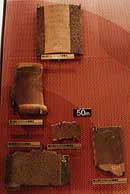 The
surface of ceramic roof tiles boiled when exposed directly to the heat flash,
leaving a distinctive bubbling pattern. The bubbles, which were larger the shorter
the distance to the hypocenter, remain as evidence of the tremendous heat generated
by the atomic bomb. Roof tiles have shown a similar phenomenon when exposed to
temperatures of 1,800 C for four seconds in experiments. The
surface of ceramic roof tiles boiled when exposed directly to the heat flash,
leaving a distinctive bubbling pattern. The bubbles, which were larger the shorter
the distance to the hypocenter, remain as evidence of the tremendous heat generated
by the atomic bomb. Roof tiles have shown a similar phenomenon when exposed to
temperatures of 1,800 C for four seconds in experiments. |
| Scorched stones from a shrine garden |
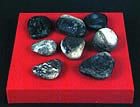 Spread
out on the floor of a garden at Gokoku Shinto Shrine, about 800 meters northwest
of the hypocenter, these stones were exposed to the ferocious flash of heat generated
by the atomic bomb explosion. The exposed surfaces turned black and cracked in
some places. (Donated by Masato Araki) Spread
out on the floor of a garden at Gokoku Shinto Shrine, about 800 meters northwest
of the hypocenter, these stones were exposed to the ferocious flash of heat generated
by the atomic bomb explosion. The exposed surfaces turned black and cracked in
some places. (Donated by Masato Araki) |
| Bamboo with scars from the heat rays |
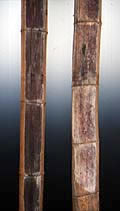 This
bamboo was cut down in a grove about three kilometers from the hypocenter. This
bamboo was cut down in a grove about three kilometers from the hypocenter.
(Donated
by Taro Tasaki and Jinemon Tanaka) |
 These
coins were piled in a stack when exposed to the heat rays. As a result of the
difference in melting point, some of the coins fused together, evidence of the
fierce, instantaneous heat released by the atomic bomb explosion. These
coins were piled in a stack when exposed to the heat rays. As a result of the
difference in melting point, some of the coins fused together, evidence of the
fierce, instantaneous heat released by the atomic bomb explosion.
(Donated by
Kiyoshi Tsuruta) |
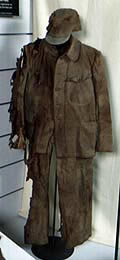 A
worker was wearing this outfit when exposed to the atomic bombing at Mitsubishi
Nagasaki Steel Works, about 1.2 kilometers from the hypo-center. The parts exposed
directly to the heat rays are scorched black. A
worker was wearing this outfit when exposed to the atomic bombing at Mitsubishi
Nagasaki Steel Works, about 1.2 kilometers from the hypo-center. The parts exposed
directly to the heat rays are scorched black.
(Donated by Mitsubishi Steel Works) |
| Helmet with the remains of a skull |
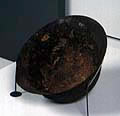 Part
of the victim's skull remains on the inner surface of this helmet found near
the hypocenter. Part
of the victim's skull remains on the inner surface of this helmet found near
the hypocenter.
(Donated by Atsuo Harada) |
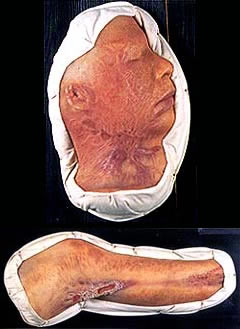 Models
of the keloid scars suffered by an atomic bomb survivor. Models
of the keloid scars suffered by an atomic bomb survivor. |
|

 The
surface of ceramic roof tiles boiled when exposed directly to the heat flash,
leaving a distinctive bubbling pattern. The bubbles, which were larger the shorter
the distance to the hypocenter, remain as evidence of the tremendous heat generated
by the atomic bomb. Roof tiles have shown a similar phenomenon when exposed to
temperatures of 1,800 C for four seconds in experiments.
The
surface of ceramic roof tiles boiled when exposed directly to the heat flash,
leaving a distinctive bubbling pattern. The bubbles, which were larger the shorter
the distance to the hypocenter, remain as evidence of the tremendous heat generated
by the atomic bomb. Roof tiles have shown a similar phenomenon when exposed to
temperatures of 1,800 C for four seconds in experiments. Spread
out on the floor of a garden at Gokoku Shinto Shrine, about 800 meters northwest
of the hypocenter, these stones were exposed to the ferocious flash of heat generated
by the atomic bomb explosion. The exposed surfaces turned black and cracked in
some places. (Donated by Masato Araki)
Spread
out on the floor of a garden at Gokoku Shinto Shrine, about 800 meters northwest
of the hypocenter, these stones were exposed to the ferocious flash of heat generated
by the atomic bomb explosion. The exposed surfaces turned black and cracked in
some places. (Donated by Masato Araki)  This
bamboo was cut down in a grove about three kilometers from the hypocenter.
This
bamboo was cut down in a grove about three kilometers from the hypocenter. These
coins were piled in a stack when exposed to the heat rays. As a result of the
difference in melting point, some of the coins fused together, evidence of the
fierce, instantaneous heat released by the atomic bomb explosion.
These
coins were piled in a stack when exposed to the heat rays. As a result of the
difference in melting point, some of the coins fused together, evidence of the
fierce, instantaneous heat released by the atomic bomb explosion. A
worker was wearing this outfit when exposed to the atomic bombing at Mitsubishi
Nagasaki Steel Works, about 1.2 kilometers from the hypo-center. The parts exposed
directly to the heat rays are scorched black.
A
worker was wearing this outfit when exposed to the atomic bombing at Mitsubishi
Nagasaki Steel Works, about 1.2 kilometers from the hypo-center. The parts exposed
directly to the heat rays are scorched black. Part
of the victim's skull remains on the inner surface of this helmet found near
the hypocenter.
Part
of the victim's skull remains on the inner surface of this helmet found near
the hypocenter. Models
of the keloid scars suffered by an atomic bomb survivor.
Models
of the keloid scars suffered by an atomic bomb survivor.